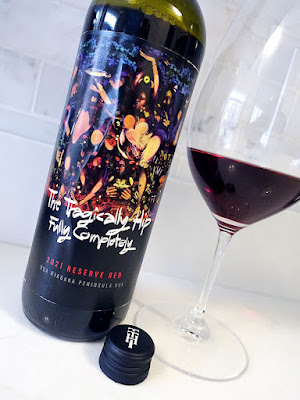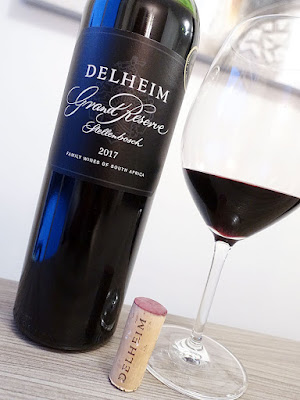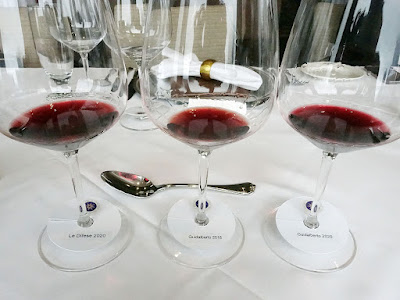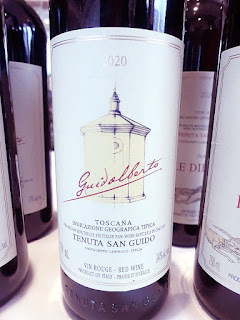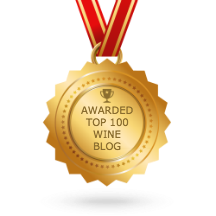red wine review is a lovely Cabernet Franc-based blend from the volcanic soils of Sicily. It is brand-new to the LCBO, arriving in last month's LCBO VINTAGES New Release Collection as an Online & Flagship Exclusive, with some quantities still available, mostly in the Ottawa area (with store transfers likely possible).
It is produced by Feudi Barone Spitaleri, an historic château and winery that was established in 1852 by Felice Spitaleri, Marquis of Sant'Elia and Baron of Solicchiata, after he returned to Sicily from his own "grand tour" in France. However, the history of the Spitaleri family goes back much further, as they were named in 1102 after the Order of the Hospitallers Knights. Moreover, the Spitaleri family have been making wine on the volcanic island of Sicily since the 14th century and were creators of the oldest branded wine in the world.
Baron Felice was a pioneer in the art of oenology and used the knowledge he acquired in France to create the first ever Bordeaux varietal blend in Italy. In 1890, he was the first to be recognized with the Royal Warrant of Appointment by HM the King of Italy. In 1907, Antonino, a descendant of Felice, stopped the commercial production of wine, but saved a few vines for family use.
Today, Feudi Barone Spitaleri continues to be proudly owned by the Spitaleri family with brothers Baron Arnaldo and Felice the latest generation of the family to run the estate. Arnaldo revived the production of premium wines in 1997 and heads up the estate, while Felice is the master winemaker of the family wine company. Following the vision of its founder, only French vines are grown on the fertile, volcanic soils of Feudi Barone Spitaleri. The vines are grown on slopes which were formed during the lava flow in 1607 and on these slopes, Felice chose two plots close to each other and created terraces, roads, over 100 km of stone walls, and built an efficient Château solely dedicated to wine production. Feudi Barone Spitaleri grows only highly-selected and sophisticated varieties, instead of the indigenous, yet more productive, varieties. Along with a number of other properties across eastern Sicily, the Spitaleri family also grows some of the most celebrated oranges.
There are two lines of wines produced by Feudi Spitaleri, with this wine coming from their Castello di Solicchiata Vineyard range. As the name suggests, this is the "Second Wine" of the estate, and is inspired by the historic Bordeaux blends using varietals that have been present on their estate in Sicily for more than 150 years. It was Baron Felice Spitaleri who first experimented and planted these varieties by following his passion for Bordelaise vines, a passion which was developed during his prolonged stay in France.
This red wine is composed of 80% Cabernet Franc, 10% Cabernet Sauvignon, and 10% Merlot that was grown on 80 hectares of terraced vineyards with alberello (bush) training. The vineyard is situated on the southwestern slopes of Mount Etna, on volcanic soils, at 800 metres above sea level. After hand-harvesting the grapes, they were macerated (and fermented) in conical oak tanks. The wine was matured for over two years in French Allier and Tronçais oak barriques, followed by further refinement in bottle for three years.
In 2012, the growing season in the Mount Etna area was hot and very dry, with no rain from May to October. As temperatures were well above average during summer, it was one of the warmest ever recorded in Etna, and irrigation was necessary for most growers because the vines were highly stressed. Many growers picked early, however, those who waited for the October rains were rewarded with grapes that offered a better balance between sugar and acidity. From a very good to outstanding vintage, let's see how this 2012 Etna red wine from Sicily is tasting tonight...
This blend of 80% Cabernet Franc, 10% Cabernet Sauvignon, and 10% Merlot has a medium+ to medium-high intensity nose that is immediately appealing, while revealing somewhat maturing aromas of dried cherry, rose floral, savoury earth, exotic spices, and cedar wood, plus volcanic ash minerals emerging with time in the glass. The dry, medium-full bodied palate is quite astringent with drying, mouth puckering tannins. Flavours are savoury with wet earth, cedar wood, cocoa, dark minerals, and oak spice nuanced with dried cherry and rose floral. Mouthwatering acids are juicy and succulent. The long finish is dry with savoury earth, and cedar notes, plus touches of exotic and sweet spices. This recommended buy is a wine for the table to pair with big red meats. Score: 91 pts
Other fine wines by Feudi Barone Spitaleri can be ordered through their Agent - Noble Estates Wines & Spirits.
It is produced by Feudi Barone Spitaleri, an historic château and winery that was established in 1852 by Felice Spitaleri, Marquis of Sant'Elia and Baron of Solicchiata, after he returned to Sicily from his own "grand tour" in France. However, the history of the Spitaleri family goes back much further, as they were named in 1102 after the Order of the Hospitallers Knights. Moreover, the Spitaleri family have been making wine on the volcanic island of Sicily since the 14th century and were creators of the oldest branded wine in the world.
Baron Felice was a pioneer in the art of oenology and used the knowledge he acquired in France to create the first ever Bordeaux varietal blend in Italy. In 1890, he was the first to be recognized with the Royal Warrant of Appointment by HM the King of Italy. In 1907, Antonino, a descendant of Felice, stopped the commercial production of wine, but saved a few vines for family use.
Today, Feudi Barone Spitaleri continues to be proudly owned by the Spitaleri family with brothers Baron Arnaldo and Felice the latest generation of the family to run the estate. Arnaldo revived the production of premium wines in 1997 and heads up the estate, while Felice is the master winemaker of the family wine company. Following the vision of its founder, only French vines are grown on the fertile, volcanic soils of Feudi Barone Spitaleri. The vines are grown on slopes which were formed during the lava flow in 1607 and on these slopes, Felice chose two plots close to each other and created terraces, roads, over 100 km of stone walls, and built an efficient Château solely dedicated to wine production. Feudi Barone Spitaleri grows only highly-selected and sophisticated varieties, instead of the indigenous, yet more productive, varieties. Along with a number of other properties across eastern Sicily, the Spitaleri family also grows some of the most celebrated oranges.
There are two lines of wines produced by Feudi Spitaleri, with this wine coming from their Castello di Solicchiata Vineyard range. As the name suggests, this is the "Second Wine" of the estate, and is inspired by the historic Bordeaux blends using varietals that have been present on their estate in Sicily for more than 150 years. It was Baron Felice Spitaleri who first experimented and planted these varieties by following his passion for Bordelaise vines, a passion which was developed during his prolonged stay in France.
This red wine is composed of 80% Cabernet Franc, 10% Cabernet Sauvignon, and 10% Merlot that was grown on 80 hectares of terraced vineyards with alberello (bush) training. The vineyard is situated on the southwestern slopes of Mount Etna, on volcanic soils, at 800 metres above sea level. After hand-harvesting the grapes, they were macerated (and fermented) in conical oak tanks. The wine was matured for over two years in French Allier and Tronçais oak barriques, followed by further refinement in bottle for three years.
In 2012, the growing season in the Mount Etna area was hot and very dry, with no rain from May to October. As temperatures were well above average during summer, it was one of the warmest ever recorded in Etna, and irrigation was necessary for most growers because the vines were highly stressed. Many growers picked early, however, those who waited for the October rains were rewarded with grapes that offered a better balance between sugar and acidity. From a very good to outstanding vintage, let's see how this 2012 Etna red wine from Sicily is tasting tonight...
Tasting Note:
SOLICCHIATA SECONDO DI CASTELLO 2012 - IGP Sicily, Italy (#46776) (XD) - $34.95This blend of 80% Cabernet Franc, 10% Cabernet Sauvignon, and 10% Merlot has a medium+ to medium-high intensity nose that is immediately appealing, while revealing somewhat maturing aromas of dried cherry, rose floral, savoury earth, exotic spices, and cedar wood, plus volcanic ash minerals emerging with time in the glass. The dry, medium-full bodied palate is quite astringent with drying, mouth puckering tannins. Flavours are savoury with wet earth, cedar wood, cocoa, dark minerals, and oak spice nuanced with dried cherry and rose floral. Mouthwatering acids are juicy and succulent. The long finish is dry with savoury earth, and cedar notes, plus touches of exotic and sweet spices. This recommended buy is a wine for the table to pair with big red meats. Score: 91 pts
Other fine wines by Feudi Barone Spitaleri can be ordered through their Agent - Noble Estates Wines & Spirits.











